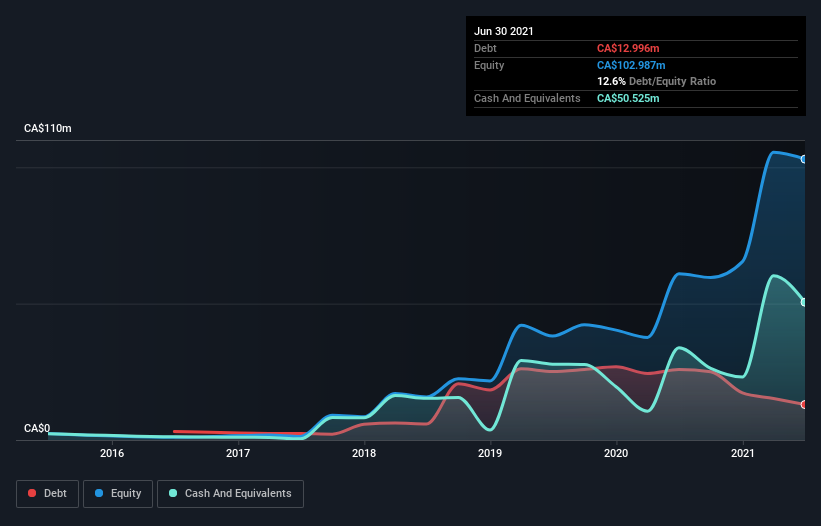Warren Buffett famously said, 'Volatility is far from synonymous with risk.' It's only natural to consider a company's balance sheet when you examine how risky it is, since debt is often involved when a business collapses. Importantly, NanoXplore Inc. (TSE:GRA) does carry debt. But the real question is whether this debt is making the company risky.
When Is Debt A Problem?
Debt assists a business until the business has trouble paying it off, either with new capital or with free cash flow. If things get really bad, the lenders can take control of the business. However, a more usual (but still expensive) situation is where a company must dilute shareholders at a cheap share price simply to get debt under control. Of course, debt can be an important tool in businesses, particularly capital heavy businesses. When we examine debt levels, we first consider both cash and debt levels, together.
See our latest analysis for NanoXplore
How Much Debt Does NanoXplore Carry?
As you can see below, NanoXplore had CA$13.0m of debt at June 2021, down from CA$25.9m a year prior. But it also has CA$50.5m in cash to offset that, meaning it has CA$37.5m net cash.

How Strong Is NanoXplore's Balance Sheet?
According to the last reported balance sheet, NanoXplore had liabilities of CA$24.5m due within 12 months, and liabilities of CA$17.8m due beyond 12 months. Offsetting this, it had CA$50.5m in cash and CA$12.3m in receivables that were due within 12 months. So it can boast CA$20.5m more liquid assets than total liabilities.
This surplus suggests that NanoXplore has a conservative balance sheet, and could probably eliminate its debt without much difficulty. Simply put, the fact that NanoXplore has more cash than debt is arguably a good indication that it can manage its debt safely. When analysing debt levels, the balance sheet is the obvious place to start. But ultimately the future profitability of the business will decide if NanoXplore can strengthen its balance sheet over time. So if you want to see what the professionals think, you might find this free report on analyst profit forecasts to be interesting.
In the last year NanoXplore wasn't profitable at an EBIT level, but managed to grow its revenue by 7.0%, to CA$68m. We usually like to see faster growth from unprofitable companies, but each to their own.
So How Risky Is NanoXplore?
By their very nature companies that are losing money are more risky than those with a long history of profitability. And the fact is that over the last twelve months NanoXplore lost money at the earnings before interest and tax (EBIT) line. Indeed, in that time it burnt through CA$15m of cash and made a loss of CA$12m. Given it only has net cash of CA$37.5m, the company may need to raise more capital if it doesn't reach break-even soon. Even though its balance sheet seems sufficiently liquid, debt always makes us a little nervous if a company doesn't produce free cash flow regularly. The balance sheet is clearly the area to focus on when you are analysing debt. But ultimately, every company can contain risks that exist outside of the balance sheet. For instance, we've identified 3 warning signs for NanoXplore (1 doesn't sit too well with us) you should be aware of.
At the end of the day, it's often better to focus on companies that are free from net debt. You can access our special list of such companies (all with a track record of profit growth). It's free.
When trading stocks or any other investment, use the platform considered by many to be the Professional's Gateway to the Worlds Market, Interactive Brokers. You get the lowest-cost* trading on stocks, options, futures, forex, bonds and funds worldwide from a single integrated account. Promoted
Valuation is complex, but we're here to simplify it.
Discover if NanoXplore might be undervalued or overvalued with our detailed analysis, featuring fair value estimates, potential risks, dividends, insider trades, and its financial condition.
Access Free AnalysisThis article by Simply Wall St is general in nature. We provide commentary based on historical data and analyst forecasts only using an unbiased methodology and our articles are not intended to be financial advice. It does not constitute a recommendation to buy or sell any stock, and does not take account of your objectives, or your financial situation. We aim to bring you long-term focused analysis driven by fundamental data. Note that our analysis may not factor in the latest price-sensitive company announcements or qualitative material. Simply Wall St has no position in any stocks mentioned.
*Interactive Brokers Rated Lowest Cost Broker by StockBrokers.com Annual Online Review 2020
Have feedback on this article? Concerned about the content? Get in touch with us directly. Alternatively, email editorial-team (at) simplywallst.com.
About TSX:GRA
NanoXplore
A graphene company, manufactures and supplies graphene powder for use in transportation and industrial markets in Australia.
Flawless balance sheet and slightly overvalued.
Similar Companies
Market Insights
Community Narratives




